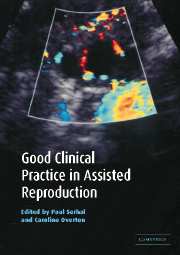Book contents
- Frontmatter
- Contents
- List of contributors
- Foreword by Bob Edwards
- Preface
- 1 Clinical assessment of the woman for assisted conception
- 2 Clinical assessment and management of the infertile man
- 3 Laboratory assessment of the infertile man
- 4 Donor insemination
- 5 Treatment options prior to IVF
- 6 Strategies for superovulation for IVF
- 7 Techniques for IVF
- 8 Ovarian hyperstimulation syndrome
- 9 Early pregnancy complications after assisted reproductive technology
- 10 Oocyte donation
- 11 Surrogacy
- 12 Clinical aspects of preimplantation genetic diagnosis
- 13 Controversial issues in assisted reproduction
- 14 Alternatives to in vitro fertilization: gamete intrafallopian transfer and zygote intrafallopian transfer
- 15 Counselling
- 16 Good nursing practice in assisted conception
- 17 Setting up an IVF unit
- 18 Information technology aspects of assisted conception
- 19 Assisted reproductive technology and older women
- 20 Ethical aspects of controversies in assisted reproductive technology
- Index
- Plate section
11 - Surrogacy
Published online by Cambridge University Press: 22 October 2009
- Frontmatter
- Contents
- List of contributors
- Foreword by Bob Edwards
- Preface
- 1 Clinical assessment of the woman for assisted conception
- 2 Clinical assessment and management of the infertile man
- 3 Laboratory assessment of the infertile man
- 4 Donor insemination
- 5 Treatment options prior to IVF
- 6 Strategies for superovulation for IVF
- 7 Techniques for IVF
- 8 Ovarian hyperstimulation syndrome
- 9 Early pregnancy complications after assisted reproductive technology
- 10 Oocyte donation
- 11 Surrogacy
- 12 Clinical aspects of preimplantation genetic diagnosis
- 13 Controversial issues in assisted reproduction
- 14 Alternatives to in vitro fertilization: gamete intrafallopian transfer and zygote intrafallopian transfer
- 15 Counselling
- 16 Good nursing practice in assisted conception
- 17 Setting up an IVF unit
- 18 Information technology aspects of assisted conception
- 19 Assisted reproductive technology and older women
- 20 Ethical aspects of controversies in assisted reproductive technology
- Index
- Plate section
Summary
In the United Kingdom (UK) and the United States (US) surrogacy is an accepted treatment option for certain specific causes of childlessness, but most countries do not allow it (Jones & Cohen, 2001). Until IVF produced an alternative, ‘natural surrogacy’ was the only treatment option available to women with congenital absence of a uterus or women who had lost their uterus to surgery. In vitro fertilization surrogacy is required by relatively few couples and accounts for approximately 1% of IVF treatment cycles at Bourn Hall (Brinsden et al., 2000) and only 0.1% of assisted reproductive treatment cycles in the UK (Human Fertilisation and Embryology Authority, 2000).
Definition of terms
Considerable confusion exists over the terms used in connection with surrogacy. ‘Natural surrogacy’, sometimes known as ‘partial surrogacy’, refers to an arrangement in which a female surrogate, sometimes known as the ‘surrogate mother’, agrees to be inseminated with the sperm of the male partner of the couple wanting a child, sometimes known as the ‘commissioning couple’, and this is often done without medical supervision. The resulting child is genetically the child of the female surrogate and of the male partner of the couple wanting the child, but genetically unrelated to the female partner of the couple wanting the child. ‘IVF-surrogacy’, sometimes known as ‘gestational surrogacy’ or ‘full surrogacy’, refers to an arrangement where the couple wanting a child provide both sets of gametes and, following fertilization in vitro, their embryos are transferred to the female surrogate. The resulting child is genetically the child of the couple wanting the child and genetically unrelated to the female surrogate. In this chapter the terms ‘IVF-surrogacy’ and ‘natural surrogacy’ will be used.
Keywords
- Type
- Chapter
- Information
- Good Clinical Practice in Assisted Reproduction , pp. 199 - 208Publisher: Cambridge University PressPrint publication year: 2004
- 1
- Cited by

